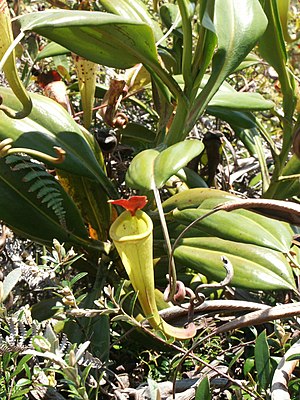Nepenthes madagascariensis
| Nepenthes madagascariensis | ||||||||||||
|---|---|---|---|---|---|---|---|---|---|---|---|---|

Nepenthes madagascariensis |
||||||||||||
| Systematics | ||||||||||||
|
||||||||||||
| Scientific name | ||||||||||||
| Nepenthes madagascariensis | ||||||||||||
| Poir. |
Nepenthes madagascariensis is a species ofthe pitcher plant family (Nepenthaceae). This carnivorous plant is onlynativeto Madagascar .
description
Nepenthes madagascariensis grows as a subshrub or shrub . Climbing only occasionally, the plants are rarely taller than 2 meters. Young parts of the plants are always densely covered with red, multicellular hair around 1 millimeter long. The internodes are extremely short on the native rosette and short shoots, but elongate to 3, rarely up to 4 centimeters. The total length of the section of leaf blade , tendril and jug is between 4 and 78 centimeters.
The leaves stand on a leaf stalk half-embracing the stem at the base , which is 2 to 5 centimeters long and 1 (rarely 0.8) to 1.5 centimeters thick and is winged over 1 to 2, rarely up to 3 centimeters. The leathery, 3 (rarely from 1) to 28 centimeters long and 2 to 8 centimeters wide leaf blade is oval or lanceolate, hairless on the upper side, but covered with scattered hair on the underside. Lanceolate spreads have a length-to-width ratio of 3 to 5: 1, oval ones rarely up to 2: 1. The leaf base is rarely tapered in a wedge shape. There are four to six, rarely up to seven side ribs on each side of the central rib , which clearly protrudes on the underside of the blade . The tendril , occasionally covered with hair, is 10 to 38 centimeters long and 1 to 3 millimeters thick.
Nepenthes madagascariensis forms less ground pitchers, but mainly air pitchers, which are quite slender and funnel-shaped and can grow to about 26 cm. Typical for this species is a wide peristome and an almost circular lid. The color is predominantly a bright quince yellow, but red pitchers have also been described.
Nepenthes madagascariensis are dioeciously separated sexes ( diocesan ), so one specimen has either only male or only female flowers. Like most of its relatives, Nepenthes madagascariensis develops paniculate inflorescences . The petals are usually reddish in color, but can turn out dark brown when exposed to intense sunlight.
The number of chromosomes is 2n = 80.
ecology
94.3% of the prey of Nepenthes madagascariensis are ants (80.2%), two-winged animals (9.7%) and beetles (4.4%). The composition of the prey differs between the dimorphic ground and air cans. In the lower pitchers there is a significantly higher proportion of ants, in the upper pitcher a higher number of flying insects. Some of the differences can also be seasonal.
Spread and endangerment
Nepenthes madagascariensis is native to Madagascar and is a lowland species. It is widespread along the east coast, to the north as far as the Masoala Peninsula, and is most common in the south around Tolagnaro . It is found on the relatively dry edges of swamps, but also on sandy soils of open, light locations, where it sometimes forms almost exclusive populations.
This species is classified as vulnerable by the IUCN .
Botanical history
The first tangible mention of Nepenthes madagascariensis comes from the year 1661, when the French Étienne de Flacourt was traveling to Madagascar and there came across the plant called "Anramitaco".
The species was first officially described in 1798 by Jean Louis Marie Poiret . Two varieties, the Nepenthes madagascariensis var. Cylindrica, first described in 1906, and the var. Macrocarpa from 1891, have meanwhile been synonymous, other sub-taxa are missing.
Individual evidence
- ↑ a b c d Bengt Jonsell, Monique Keraudren-Aymonin, Rudolf Schmid-Hollinger: Cruciferae, Moringaceae, Droseraceae, Nepenthaceae (= Flore de Madagascar et des Comores. 84-87). , 1982, ISBN 2-85654-163-1 , pp. 44-48.
- ^ Nepenthes madagascariensis at Tropicos.org. In: IPCN Chromosome Reports . Missouri Botanical Garden, St. Louis
- ^ Katja Rembold, Eberhard Fischer, Markus A. Wetzel, Wilhelm Barthlott : Prey composition of the pitcher plant Nepenthes madagascariensis. In: Journal of Tropical Ecology. Vol. 26, No. 4, 2010, ISSN 0266-4674 , pp. 365-372, doi : 10.1017 / S026646741000012X .
- ^ A b Matthew Jebb, Martin Cheek: A Skeletal Revision of Nepenthes (Nepenthaceae). In: Blumea. Vol. 42, 1997, ISSN 0006-5196 , pp. 1–106, here pp. 36–37, ( digital version (PDF; 8.82 MB) ).
- ↑ Clarke, C., Cantley, R., Nerz, J., Rischer, H. & Witsuba, A. 2000. Nepenthes madagascariensis . In: IUCN 2010. IUCN Red List of Threatened Species. Version 2010.1. <www.iucnredlist.org>. (accessed June 5, 2010)
Web links
- Stewart McPherson, translation RH Siegfried Hartmeyer: An expedition to Madagascar. (accessed on June 6, 2010)
- Nepenthes madagascariensis at www.bio-schmidhol.ch (accessed on June 6, 2010)